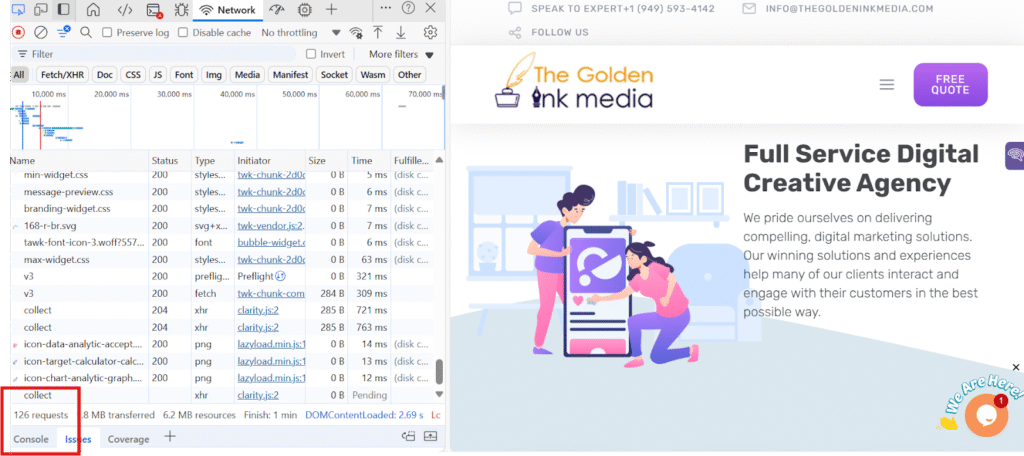Checklist for Technical SEO Analysis
- September 14, 2025
- Digital Marketing, Search Engine Optimization(SEO), Technical SEO
Search Engine Optimization is a science in itself. To rank top on Google, you have to cater to both the tech and visual aspects of a website. And that’s where technical SEO optimization comes into play. Technical SEO is divided into four main components: Website loading speed, website functionality, content optimization, and user friendliness. If you are an SEO advisor or just starting out with SEO, this guide breaks down the different components and makes them easy to understand. So, let’s dive deeper and learn about the basics of technical SEO analysis.
Website Loading Speed Time
It is an important aspect when it comes to technical seo analysis. Website loading speed impacts user satisfaction with the website. Researchers claim that on average, websites worldwide load in 19 seconds, which negatively impacts the user experience. Google’s speed test is perfect if you want to analyse your website’s speed.
Here’s an example of the performance report, which covers multiple aspects such as first contentful paint, total blocking time, etc., of this website. You can see the basics of the performance report here.

Improve Server Response Time
Server response time refers to the period of time it takes to load the HTML code to begin rendering the page. Basically, when you click on a link in Google SERPs, it sends the request to the server to display the page, and the time it takes to show you that page is the server response time. Google says you should keep your server time under 200 ms.
If your server time is high, you can check and rectify it through the following steps:
- Analyze the data to understand the reasons behind high server response times.
- Measure server performance to identify potential bottlenecks and implement necessary fixes.
- Continuously monitor to detect any regressions and ensure consistent performance improvements.
Optimize and Reduce Image Size
Image size impacts the overall website loading time. Google Page Speed Insights gives you the details of the exact images that need to be compressed for an optimal loading time. It is an important part of technical seo analysis.

Here’s an example of how the insights showcase details about images.
Minimize the Render-Blocking JavaScript, HTML, and CSS
The first document to lead is the HTML, and the file should not be heavy. Moreover, additional CSS and JavaScript also impact the loading time. That’s why it is often recommended to define async and delayed loading time for certain JS scripts in the website code.

For example, if a website uses older versions of JavaScript, Google often shows a recommendation to use the latest versions.
You can remove render-blocking JavaScript by following Google’s guidelines and by using these three methods:
- Inline JavaScript
- Make JavaScript Asynchronous
- Defer loading of JavaScript
Moreover, you may be required to minimize the size of the external CSS through these methods:
- For small external CSS files, it is recommended to inline them to help the browser render the page faster.
- For larger CSS files, prioritize the visible content by inlining only the CSS required for above-the-fold elements, and defer loading the remaining styles to improve page performance.
If you are using WordPress, you can auto-optimize the CSS and JS with the help of plugins.
Limit the number of HTTPs requests
As per expert recommendations, the HTML requests should be under 100. Though there is no exact number suggested by Google. You can check the HTTPs request through your browser console, in the network section.

For example, this page makes 126 requests, as you can see on the left-hand side within the red box.
Set the Browser Cache Policy
When a user visits a website for the first time, the browser cache automatically stores certain resources on their device. On subsequent visits, these cached resources allow the page to load faster, enabling users to access content more quickly. This caching mechanism improves page load speed for returning visitors.
Reduce the Number of Directs
Redirects are typically considered a negative signal when it comes to SEO. It is not exactly a technical seo best practice. A large number of redirects slows down your website and thus impacts overall user experience. You can use the noindex tag in the robots to avoid applying redirects in the website. You can check out the pages with 404 error on the Screaming Frog and work on them accordingly.
Make Sure Your Site is Mobile Friendly
Most people use the website on mobile. So, for technical seo optimization, your website should be mobile-friendly. Meaning, it must load seamlessly on the mobile, adjust to the screen, without any overlapping of images or texts. Aside from this, it is good for overall SEO as the google prioritizes mobile indexation.
Build Search Engine Friendly URLs
It is an important aspect of technical SEO optimization. The URLs must be short and use a keyword, i.e., only focus on the keyword. Moreover, they must meet the intent of the page, and unnecessary terms and jargon must be avoided.
Use the Secure Protocol
An SSL certificate is important on all valid websites, and it is an important aspect of technical SEO optimization. It showcases to users that the website is valid, legal, and is not made to dupe them. You can purchase an SSL certificate while buying the domain.
Set Your Preferred Version
It’s important to ensure that all versions of your website point to your preferred version. Visitors accessing any alternate version should be automatically redirected to the correct one.
The different versions include:
- http://site.com
- https://site.com
- http://www.site.com
- https://www.site.com
Set Up Correct 301 Redirects
Another important aspect of technical SEO analysis is the 301 redirects. So basically, a 301 redirect tells the search engine that a particular web page has been moved to a new URL altogether. It must be carefully and correctly set to ensure utmost technical SEO optimization.
Test Your Robots.txt File to Guide Google
Crawlability issues often stem from the robots.txt file. Testing this file ensures that Googlebot knows which pages to crawl and which to ignore, giving proper access to your website’s content.
You can check your robots.txt file by visiting http://yourdomain.com/robots.txt. Ensure that the file’s structure and order are correct, similar to the example shown below:
Use the robots.txt Tester tool from Search Console to write or edit robots.txt files for your site. The tool is easy to use and shows you whether your robots.txt file blocks Google web crawlers from specific URLs. The ideal situation would be to have no errors:
Verify Indexed Content
It is advisable to check the indexed and no-indexed pages on your website. There can be scenarios where you have incorrectly set a page to no-index, thereby removing it from SERPs entirely.
Review Your Sitemap
A sitemap helps search engines understand the structure of your website and find all your important pages. Regularly reviewing your sitemap ensures that it is up-to-date and accurately reflects your website’s content. Make sure all relevant pages are included, outdated or deleted pages are removed, and the sitemap follows proper formatting standards. Submitting an updated sitemap to Google Search Console can improve crawl efficiency and help your pages appear more reliably in search results.
Here’s an example of sitempap. It should be properly organized to match the website structure.

Optimize Your Crawl Budget
The concept of a crawl budget refers to the number of pages a search engine crawls on your site within a given time period. While smaller websites usually don’t need to worry, larger sites with thousands of pages can benefit from optimizing how Googlebot and other crawlers access their content.
Optimizing your crawl budget ensures that important pages are crawled and indexed efficiently, while low-value or duplicate pages don’t consume unnecessary resources. This can be achieved by fixing broken links, using proper canonical tags, updating your robots.txt file, and maintaining a clean, well-structured sitemap. Regular monitoring in Google Search Console helps you understand crawl patterns and make improvements.
Avoid Using Meta Refresh
A meta refresh is an HTML tag that automatically redirects a user from one page to another after a set period of time. While it can be used for simple redirects, it is generally discouraged for SEO and user experience.
The main issues are:
- SEO Impact: Search engines may treat meta refresh redirects differently than standard 301 redirects, potentially affecting page ranking.
- User Experience: Users may be confused or frustrated by sudden page changes, especially if the delay is long.
- Accessibility: Screen readers and other assistive technologies may not handle meta refresh redirects well, creating accessibility problems.
Best Practice: Use server-side 301 redirects instead. These provide a clear, permanent redirect that preserves SEO value and ensures a smoother experience for users.
Use Hreflang for Multi-Language Websites
Hreflang tags help search engines understand which language or regional version of a page to show in search results. Using the rel=”alternate” hreflang=”x” attributes ensures that users see the correct version for their language or region.
Hreflang is particularly useful in the following scenarios:
- Single-language content with translated templates: When the main content remains in one language but elements like navigation or footer are translated, it is commonly used for user-generated content.
- Small regional variations: When content is largely the same but targeted to different regions, such as an English-language site aimed at the US, UK, and Ireland.
- Fully translated content: When you provide complete translations of each page for multiple languages, you ensure that users and search engines see the appropriate version.
Make Sure Tracking Codes are Working Properly
It is an important aspect of technical SEO analysis and optimization. Ensure both the tracking codes, Google Analytics, and Google Search Console are working fine. Any mistake in code or pasting incomplete code can display wrong or no traffic at all on the analytics. If you are adding code through Google Tag Manager, it is best to demo test it.
Redirect/Replace Broken Links & Resources
It is important to check for broken links as part of technical SEO analysis. Broken links and missing resources can harm both user experience and SEO performance. When visitors encounter 404 errors or inaccessible files, it can lead to frustration, reduced engagement, and lower search engine rankings. To address this, regularly audit your website to identify broken links and outdated resources. Replace them with correct URLs or relevant content, or implement proper 301 redirects to guide users and search engines to the appropriate pages. Maintaining functional links ensures smooth navigation, preserves link equity, and supports overall website credibility.
Audit Internal Links
Conducting a thorough internal link audit is an essential part of technical SEO analysis. By ensuring that all pages are properly linked and that anchor text is optimized, you improve website navigation and help search engines efficiently crawl and index your content. Fixing broken links and redirect issues also strengthens your overall technical SEO optimization.
Update or Remove Duplicate Content
Addressing duplicate content is a crucial step in technical SEO optimization. Regularly updating, consolidating, or removing duplicate pages ensures each page provides unique value, improves search engine rankings, and enhances the user experience. Following technical SEO best practices in content management prevents dilution of link equity and helps search engines understand your site structure.
Use Structured Data
Implementing structured data is a key technical SEO best practice that helps search engines interpret the content and context of your pages. Proper schema markup can enhance search listings with rich results like reviews, ratings, or product information, boosting visibility and click-through rates while supporting your technical SEO optimization efforts.
Add Breadcrumbs
Adding breadcrumbs improves both user experience and search engine understanding, making it a valuable part of technical SEO optimization. Breadcrumbs clarify your site hierarchy, help users navigate easily, and assist search engines in indexing your pages correctly, aligning with technical SEO best practices.
If you want to rank your website on Google, the you must conduct a technical SEO analysis. Our checklist guides you through the various components you must consider for an optimal technical SEO analysis. Moreover, we can help you conduct analysis and follow the technical SEO best practices. Get in touch to get started!
Priyanka is a long form content writer with experience of over 5 years. She has worked in multiple industries including real estate, ecommerce services and products, hospitality, business formation, and more. In her free time, she loves to read books, click photographs, and listen to podcasts.
About us and this blog
We are a digital marketing company with a focus on helping our customers achieve great results across several key areas.
Request a free quote
We offer professional SEO services that help websites increase their organic search score drastically in order to compete for the highest rankings even when it comes to highly competitive keywords.
Subscribe to our newsletter!
More from our blog
See all postsRecent Posts
- Checklist for Technical SEO Analysis September 14, 2025
- How to Use Reddit for SEO? August 24, 2025
- Google AI Mode: How Search Experience has Transformed? August 21, 2025










